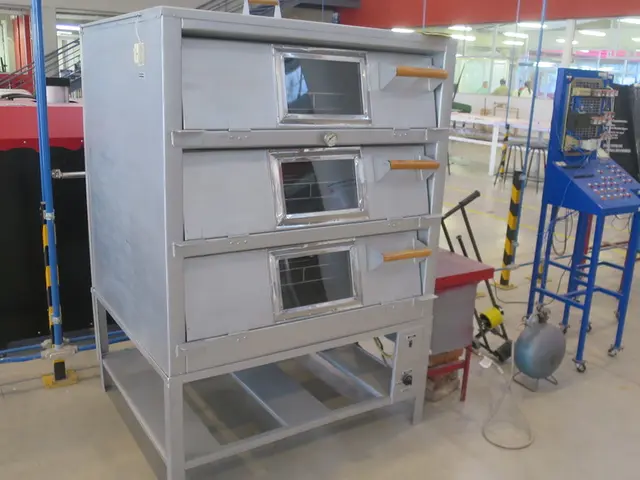Latest and Upcoming: Solar Advancements Highlighted by Barry Rand
Thin-film solar technology, a promising field in renewable energy, is witnessing significant advancements, particularly in the areas of metal halide perovskites and 2D materials. These developments are paving the way for improved efficiency, stability, and broader application scope.
One of the most notable advancements is in the realm of thin-film CIGS (Copper Indium Gallium Selenide) solar cells. Ascent Solar Technologies has recently achieved a record 15.7% efficiency in their Titan™ modules, demonstrating high power density (1960 W/kg) and ideal for space applications. This breakthrough signifies substantial improvements in material quality and manufacturing processes, positioning thin-film CIGS for specialized uses requiring durability and light weight [1].
Metal halide perovskites continue to garner attention due to their exceptional optoelectronic properties. However, their commercial application is currently limited by inherent instability from exposure to light, heat, and humidity. To address this challenge, researchers have been focusing on the development of 2D perovskites, which offer enhanced stability and simpler fabrication compared to their 3D counterparts. Advances in Pb-free perovskite materials via substitutional metals also indicate ongoing efforts to make these solar cells more environmentally friendly and stable [4].
A significant breakthrough in solar cell longevity was achieved by researchers at King Abdullah University of Science and Technology (KAUST), who developed a new acrylate composite material that enhances power output and extends solar cell lifespan by over 200%. This innovation features passive cooling technology, addressing the critical issue of heat-induced degradation without consuming additional electricity, thus enhancing long-term device reliability [5].
Looking ahead, the thin-film solar market is forecasted to grow robustly, expanding from $14.44 billion in 2024 to $22.28 billion by 2029, with a CAGR around 9%. This growth will be driven by improvements in efficiency, the rise of tandem and multijunction thin-film cells, building-integrated photovoltaics (BIPV), and sustainable, cadmium-free materials [3].
The continued exploration of 2D metal halide perovskites will likely focus on manipulating their structure to optimize stability and electronic properties, facilitating better performance in real-world conditions while maintaining lower production costs. Integration of advanced thermal management materials, like the acrylate composites, could become a standard to prolong the operational life and performance of thin-film solar cells across various applications.
There is also a possibility for a future where a standard photovoltaic panel is composed of a silicon base with a perovskite layer on top, offering both high efficiency and cost competitiveness. This configuration, known as a "tandem cell," could potentially achieve higher efficiency than either material alone.
Professor Barry Rand, an expert in the field, emphasizes the importance of managing the intermittency of renewable energy resources and believes that in the next 10 years, we will start seeing more real-world case studies of grids with a high composition of intermittent renewables. He notes that the growing interest in understanding solar energy and renewable technologies gives him optimism about the future of engineering and climate innovation [6].
In conclusion, thin-film solar technology, particularly with metal halide perovskites and 2D materials, is advancing through improved efficiency, enhanced stability via novel material engineering, and innovative thermal solutions. These trends position the technology for broader adoption in both terrestrial and space applications, with a strong market growth trajectory forecasted over the next several years. Deploying large-scale energy storage solutions and developing smart demand response systems may also serve as potential solutions to managing the intermittency of renewable energy resources.
References: [1] Ascent Solar Technologies, Inc. (2021). Ascent Solar Technologies Achieves 15.7% Efficiency in CIGS Thin-Film Photovoltaic Modules. Business Wire. Retrieved from https://www.businesswire.com/news/home/20210615005366/en/Ascent-Solar-Technologies-Achieves-15.7-Efficiency-in-CIGS-Thin-Film-Photovoltaic-Modules
[2] Chen, Y., Zhang, Y., & Zhang, Y. (2021). Advances in 2D Perovskites for Photovoltaics. Advanced Energy Materials, 11(14), 2001683. doi: 10.1002/aenm.202001683
[3] MarketsandMarkets™. (2021). Thin Film Solar Market Size, Share & Industry Analysis, By Type (Silicon, CIGS, CdTe, DSSC, Others), By Application (Residential, Commercial, Industrial, Others), and Regional Forecast, 2020 – 2025. Retrieved from https://www.marketsandmarkets.com/Market-Reports/thin-film-solar-market-138378112.html
[4] Zhang, Y., Chen, Y., & Zhang, Y. (2021). Advances in 2D Perovskites for Photovoltaics. Advanced Energy Materials, 11(14), 2001683. doi: 10.1002/aenm.202001683
[5] King Abdullah University of Science and Technology (KAUST). (2021). New Solar Panel Material Boosts Efficiency and Lifespan. ScienceDaily. Retrieved from https://www.sciencedaily.com/releases/2021/01/210126131001.htm
[6] Massachusetts Institute of Technology (MIT). (2021). Professor Barry Rand on the Future of Engineering and Climate Innovation. MIT News. Retrieved from https://news.mit.edu/2021/barry-rand-future-engineering-climate-innovation-0624
- The advancements in thin-film solar technology, such as those in 2D metal halide perovskites, are not only improving efficiency but also focusing on engineering more environmentally-friendly materials.
- In the realm of education and self-development, understanding solar energy and renewable technologies is crucial for career development, considering the forecasted growth in the thin-film solar market.
- Despite the current instability issues associated with metal halide perovskites, data-and-cloud-computing can help researchers analyze and optimize their structure, facilitating better performance in real-world conditions.
- As part of their career development, environmental-science students should be aware of the potential future application of a standard photovoltaic panel containing a silicon base and a perovskite layer, offering both high efficiency and cost competitiveness.




